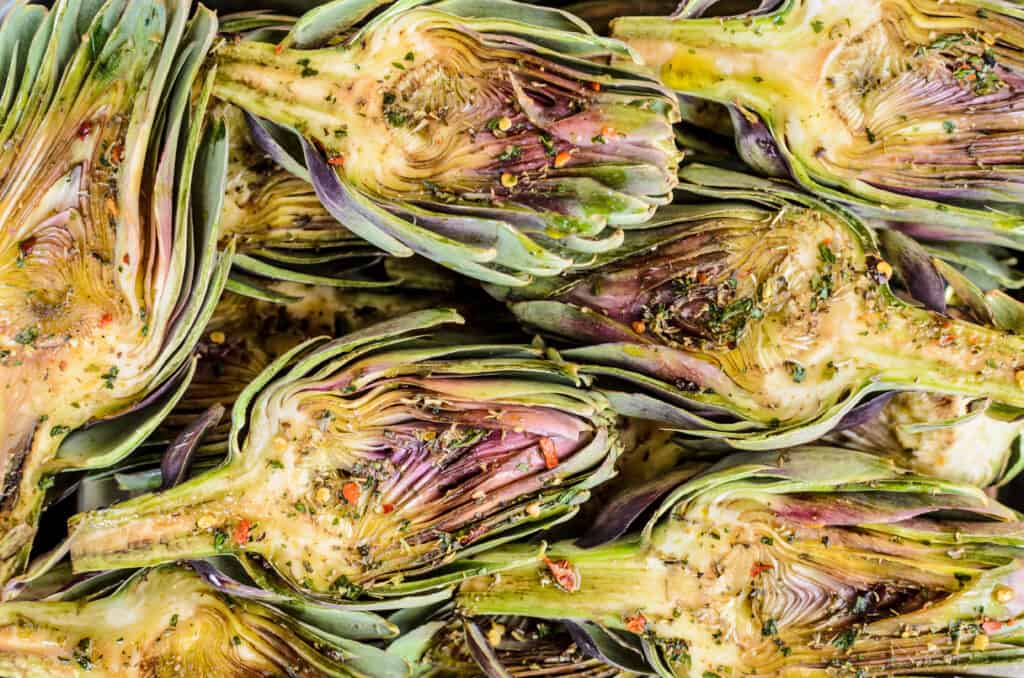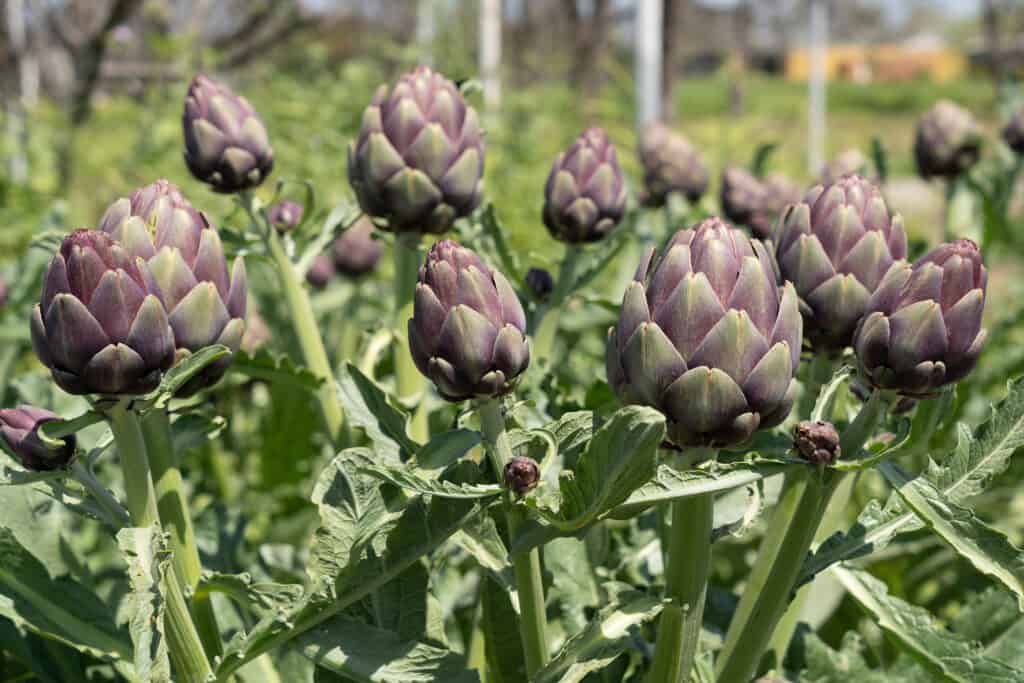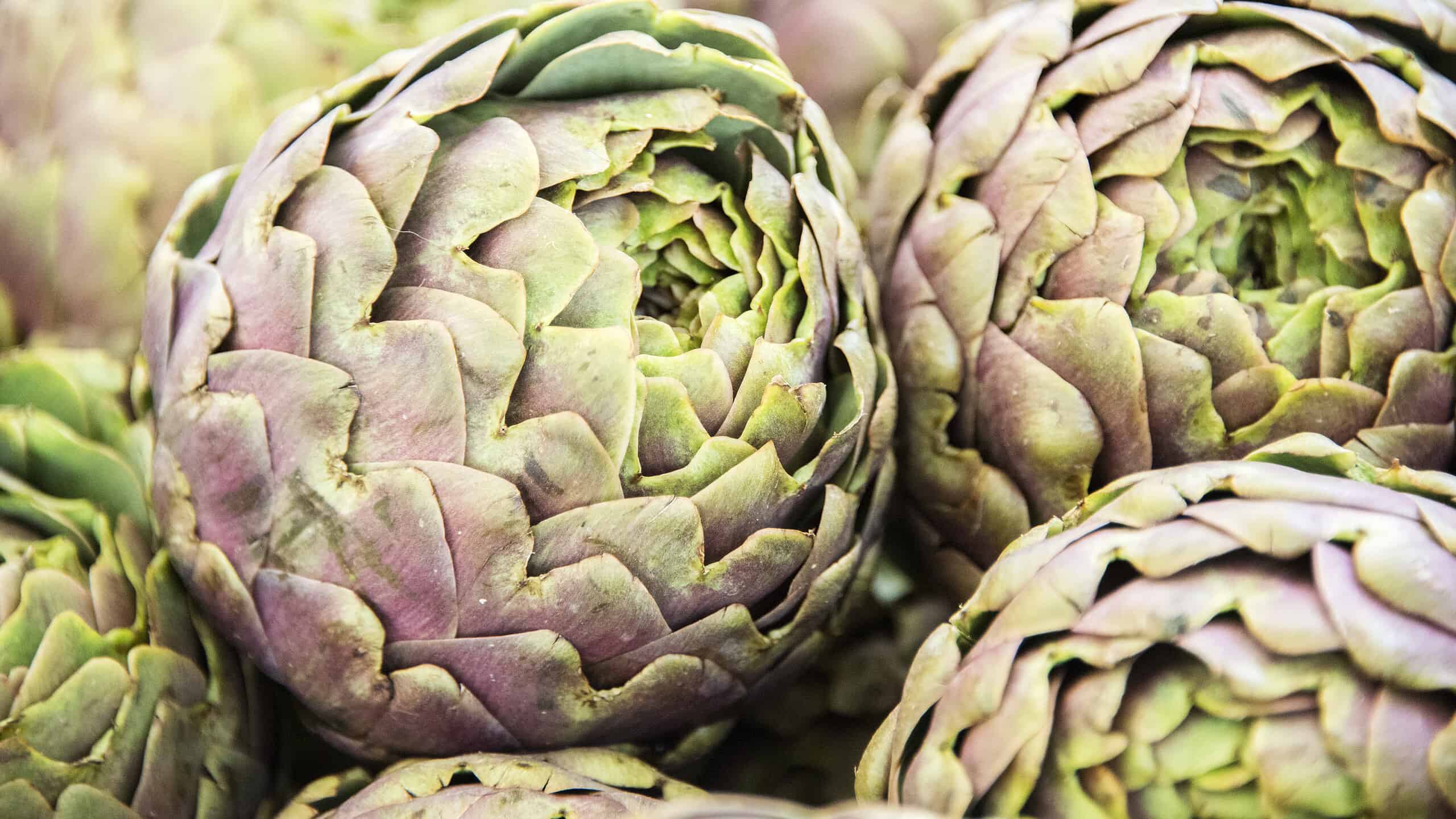With their unique appearance and delicious flavor, artichokes have become a popular vegetable in many cuisines worldwide.
While they’re widely available canned or in grocery store delis, there’s nothing like the tang and zip of a fresh artichoke. This leads to many questions, like: When are artichokes in season? How do I pick the best artichoke from the bunch? In this article, you’ll discover when artichokes are in peak season and where they grow.
Let’s dig in!
What Are Artichokes?
Believe it or not, artichokes are the flower bud of a thistle. These edible perennials are members of the Asteraceae family, which it shares with daisies, mums, and zinnias.
Artichokes are recognizable by their unique appearance. Picture a vibrant green flower bud tightly packed with protective leaves. When you hold an artichoke, it feels sturdy and robust in your hands.
The outer leaves are tough and prickly, guarding the delicate heart within.
As you peel away the layers, you’ll find tender and edible portions, from the fleshy base to the tender, pale leaves. At the center lies the prized artichoke heart, with a velvety texture and a slightly nutty taste.

Close-up of a flowering artichoke growing outdoors.
©leopictures/Shutterstock.com
Culinary Application of Artichokes
Artichokes are incredibly versatile. Chefs and food lovers use them in everything from dips to stir-fry to pizza.
These nutritious plants offer several vitamins and minerals, including:
- Potassium
- Vitamin C
- Magnesium
- Iron
- Vitamin B6
There’s a common misconception that only the artichoke heart is edible. While the center is the most versatile and arguably the most delicious part, you can make use of the rest of this plant.
You can eat artichoke stems if you peel them first. You can use this part in salads or grill them with seasoning and citrus.
The outer leaves of artichokes have a delicious edible bit at the base. You can grill the entire artichoke and pull off the leaves to dip. Eat the soft bottom portion of the leaf and discard the rest.

You can use artichokes for everything from pizza to dips.
©Vincenzo Di Dio/Shutterstock.com
Where Do Artichokes Grow?
Artichokes have a fascinating history that dates back to ancient times. Originating from the Mediterranean region, artichokes were cultivated by the Greeks and Romans. They were highly regarded for their medicinal properties and eventually spread throughout Europe during the Middle Ages.
Producers still grow artichokes in Italy and other Mediterranean regions. However, North American producers have also created a market for these delicious plants.
When Are Artichokes in Season?
Artichokes are a unique plant with two annual seasons. The ideal time to purchase fresh artichokes is in the spring or the fall, avoiding the heat and humidity of summer.
Look for fresh artichokes from March to May, then October to December. Avoid purchasing fresh artichokes from June through August, opting for canned artichokes instead.

Italy is a leading producer of artichokes.
©beats1/Shutterstock.com
How to Pick the Perfect Artichoke
Selecting the perfect fresh artichoke is essential for a delightful culinary experience. Start by choosing artichokes with tightly closed, compact leaves and a bold green color.
Look for firm and heavy artichokes that feel weighty in your hand. Gently squeeze the artichoke; it should squeak slightly, indicating freshness.
Additionally, check the cut end of the stem. If the end appears moist and fresh, that’s a good sign.
How to Grow Artichokes
Artichokes are a perennial in USDA zones 7-11—they’re a flower, remember! However, you can grow them as an annual crop almost anywhere that has plenty of sunshine and a temperate climate during the growing season.
Growing artichokes isn’t for the faint of heart. This plant is high maintenance and requires a lot of hands-on care.
Start your artichoke seeds within 8-12 weeks before the last frost. Alternatively, you can purchase root shoots to plant directly after the risk of frost has passed.
Artichokes require nutrient-rich soil with plenty of organic matter. Plan to fertilize and feed these hungry thistles regularly throughout the growing season.
Plant your artichokes in a place that gets full sun exposure. Leave ample space between sprouts for growth. Water your artichokes daily during the morning or evening to prevent shock. Artichokes thrive in moist, well-draining soil. Consider mulching the plants to trap moisture.
Use a sharp knife to harvest your artichokes when the bulbs reach 3-5 inches in diameter. Continue to care for the plants during the summer season to promote a second growth period during the fall.

Artichokes are a high-maintenance crop.
©pokku/Shutterstock.com
How to Store Artichokes
Transfer cut or store-purchased artichokes to the fridge as soon as possible. Wait to rinse your artichokes until you’re ready to eat them, as excess moisture will cause them to rot quicker.
Artichokes won’t keep long in the fridge. If you have a large harvest, consider cooking and freezing them or preserving them.
Thank you for reading! Have some feedback for us? Contact the AZ Animals editorial team.








